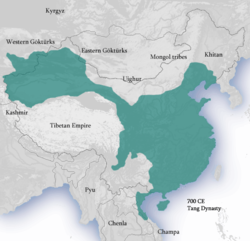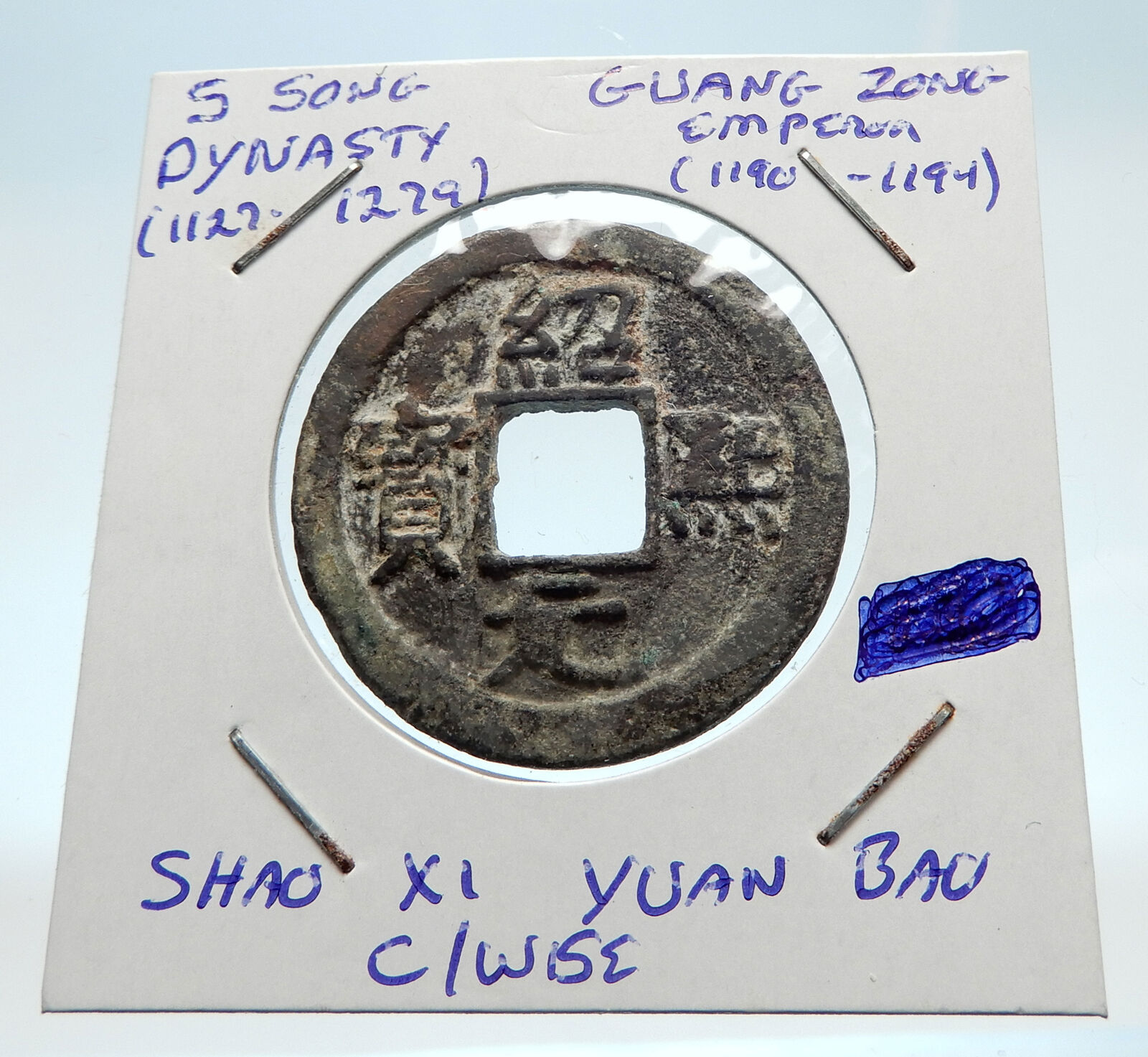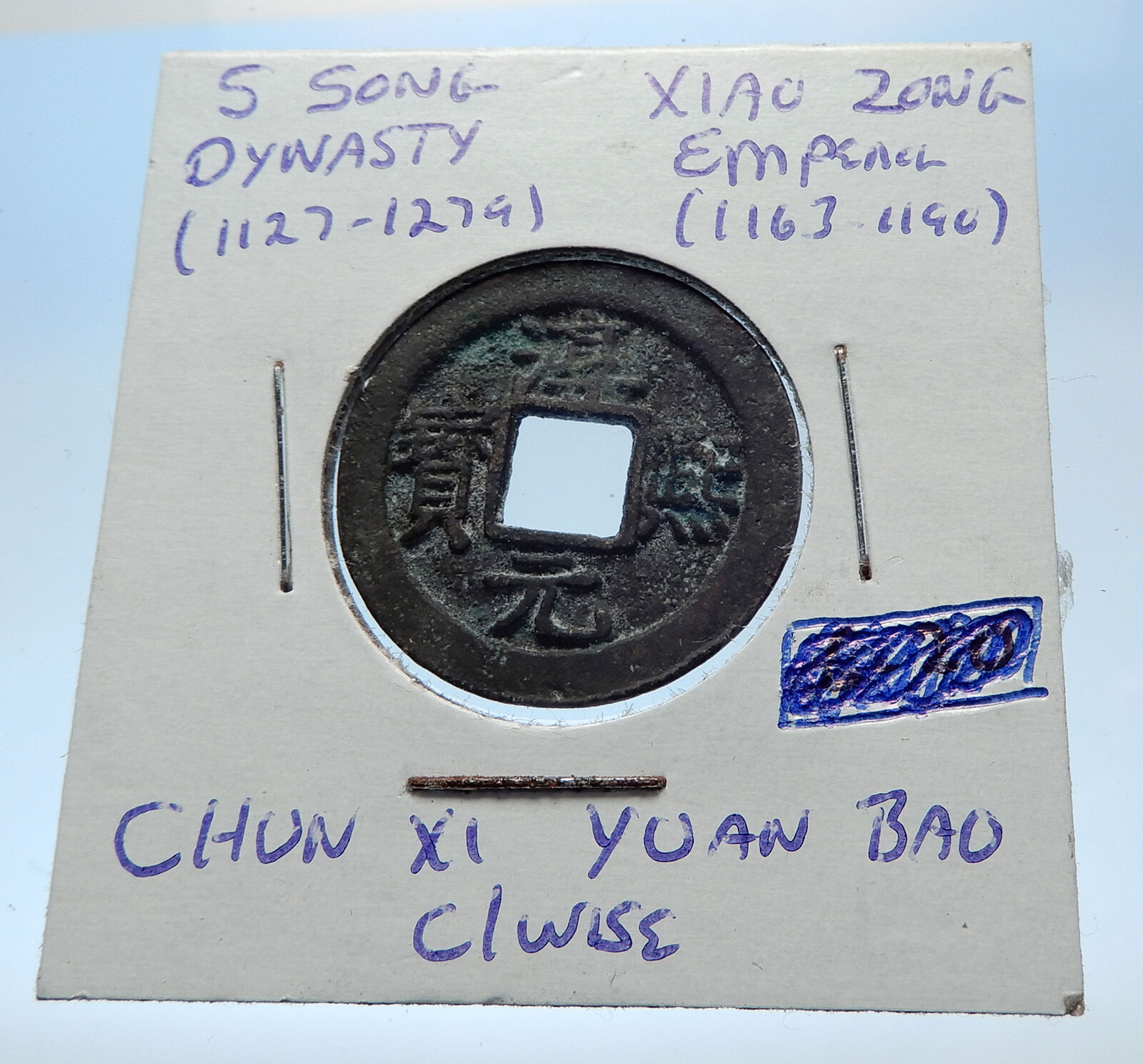|
China – Tang Dynasty (618-907 A.D.)
Wu Zong – Emperor: 845-846 AD
Bronze Tai Yuan Tong Bao Cash 22mm, Struck
845-846
AD
Reference: H# 14.50
開元通寶, Four Chinese characters, square hole within.
No shoulder. Chang, Huichang Period Tithe.
You are bidding on the exact item pictured, provided with a Certificate of Authenticity and Lifetime Guarantee of Authenticity.
 Emperor Wuzong of Tang (July 2, 814 – April 22, 846), né Li Chan, later changed to Li Yan just before his death, was an emperor of the Tang Dynasty of China, reigning from 840 to 846. Emperor Wuzong is mainly known in modern times for the religious persecution that occurred during his reign. However, he was also known for his successful reactions against incursions by remnants of the Uyghur Khanate and the rebellion by Liu Zhen, as well as his deep trust and support for chancellor Li Deyu. Emperor Wuzong of Tang (July 2, 814 – April 22, 846), né Li Chan, later changed to Li Yan just before his death, was an emperor of the Tang Dynasty of China, reigning from 840 to 846. Emperor Wuzong is mainly known in modern times for the religious persecution that occurred during his reign. However, he was also known for his successful reactions against incursions by remnants of the Uyghur Khanate and the rebellion by Liu Zhen, as well as his deep trust and support for chancellor Li Deyu.
After the Zhaoyi campaign, Li Deyu used the opportunity to carry reprisals against his political enemies in the Niu-Li Factional Struggles—those who were members of what would later be referred to as the Niu Faction (named after Niu Sengru) against Li Deyu’s Li Faction—including the former chancellors Niu Sengru and Li Zongmin—by accusing them of complicity in Liu Zhen’s rebellion. As a result, Niu and Li Zongmin were exiled to remote regions.
In 845, Emperor Wuzong wanted to create his favorite concubine, Consort Wang, empress. Li Deyu, pointing out that Consort Wang was of low birth and that she was sonless, opposed. Emperor Wuzong therefore did not do so. (Emperor Wuzong had five known sons, but very little is known about them other than their names and their princely titles.)
Late in Emperor Wuzong’s life, he began taking pills made by Taoist alchemists, which were intended to lead to immortality, and it was said that his mood became harsh and unpredictable as a side effect. By late 845, he was seriously ill. In early 846, in an attempt to ward off the illness, he changed his name to Li Yan—under the theory that under the Wu Xing cosmology, his original name of Chan (瀍) contained two instances of earth (土) while only containing one instance of water (水), which meant that he was getting suppressed by the dynasty’s own spirits (as Tang beliefs included that the dynasty was protected by earth), while Yan (炎) contained two instances of fire (火), which was more harmonious with earth. Despite this change, his conditions did not get better. The eunuchs, believing that Emperor Wuzong’s uncle Li Yi the Prince of Guang to be simple-minded, decided to make him Emperor Wuzong’s successor; they therefore had an edict issued in Emperor Wuzong’s name creating Li Yi crown prince (and changing Li Yi’s name to Li Chen). Soon thereafter, Emperor Wuzong died, and Li Chen took the throne as Emperor Xuānzong.
 The The
Tang dynasty (Chinese: 唐朝) or the Tang
Empire was an imperial dynasty of China,
preceded by the Sui dynasty and followed by the
Five Dynasties and Ten Kingdoms period.
Historians generally regard the Tang as a high
point in Chinese civilization, and a golden age
of cosmopolitan culture. Tang territory,
acquired through the military campaigns of its
early rulers, rivaled that of the Han dynasty.
The Tang capital at Chang’an (present-day Xi’an)
was the most populous city in the world in its
day.
The Lǐ family (李) founded the
dynasty, seizing power during the decline and
collapse of the Sui Empire. The dynasty was
briefly interrupted when Empress Wu Zetian
seized the throne, proclaiming the Second Zhou
dynasty (690-705) and becoming the only Chinese
empress regnant. In two censuses of the 7th and
8th centuries, the Tang records estimated the
population by number of registered households at
about 50 million people. Yet, even when the
central government was breaking down and unable
to compile an accurate census of the population
in the 9th century, it is estimated that the
population had grown by then to about 80 million
people.[9][10][b] With its large
population base, the dynasty was able to raise
professional and conscripted armies of hundreds
of thousands of troops to contend with nomadic
powers in dominating Inner Asia and the
lucrative trade-routes along the Silk Road.
Various kingdoms and states paid tribute to the
Tang court, while the Tang also conquered or
subdued several regions which it indirectly
controlled through a protectorate system.
Besides political hegemony, the Tang also
exerted a powerful cultural influence over
neighboring East Asian states such as those in
Japan and Korea.
The Tang dynasty was
largely a period of progress and stability in
the first half of the dynasty’s rule, until the
An Lushan Rebellion and the decline of central
authority in the later half of the dynasty. Like
the previous Sui dynasty, the Tang dynasty
maintained a civil-service system by recruiting
scholar-officials through standardized
examinations and recommendations to office. The
rise of regional military governors known as
jiedushi during the 9th century undermined
this civil order. Chinese culture flourished and
further matured during the Tang era; it is
traditionally considered the greatest age for
Chinese poetry. Two of China’s most famous
poets, Li Bai and Du Fu, belonged to this age,
as did many famous painters such as Han Gan,
Zhang Xuan, and Zhou Fang. Scholars of this
period compiled a rich variety of historical
literature, as well as encyclopedias and
geographical works. The adoption of the title
Tängri Qaghan by the Tang Emperor Taizong in
addition to his title as emperor was eastern
Asia’s first “simultaneous kingship”.
Many notable innovations occurred under the
Tang, including the development of woodblock
printing. Buddhism became a major influence in
Chinese culture, with native Chinese sects
gaining prominence. However, in the 840s the
Emperor Wuzong of Tang enacted policies to
persecute Buddhism, which subsequently declined
in influence. Although the dynasty and central
government had gone into decline by the 9th
century, art and culture continued to flourish.
The weakened central government largely withdrew
from managing the economy, but the country’s
mercantile affairs stayed intact and commercial
trade continued to thrive regardless. However,
agrarian rebellions in the latter half of the
9th century resulted in damaging atrocities such
as the Guangzhou massacre of 878-879.
|





 Emperor Wuzong of Tang (July 2, 814 – April 22, 846), né Li Chan, later changed to Li Yan just before his death, was an emperor of the Tang Dynasty of China, reigning from 840 to 846. Emperor Wuzong is mainly known in modern times for the religious persecution that occurred during his reign. However, he was also known for his successful reactions against incursions by remnants of the Uyghur Khanate and the rebellion by Liu Zhen, as well as his deep trust and support for chancellor Li Deyu.
Emperor Wuzong of Tang (July 2, 814 – April 22, 846), né Li Chan, later changed to Li Yan just before his death, was an emperor of the Tang Dynasty of China, reigning from 840 to 846. Emperor Wuzong is mainly known in modern times for the religious persecution that occurred during his reign. However, he was also known for his successful reactions against incursions by remnants of the Uyghur Khanate and the rebellion by Liu Zhen, as well as his deep trust and support for chancellor Li Deyu. The
The 




